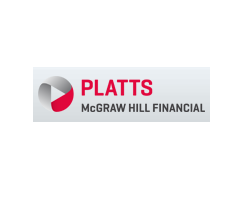Analysis: China Steel Mill Spreads Ruging, as Weak Raw Materials Find Foothold

By Hector Forster and James Leech
June 21, 2017 - Steel mill export product spreads with raw materials in China have surged in the past week on the back of a strong recovery in May, which may be incentivizing seaborne raw materials purchases as traders lock in margins.
The move may be arresting a recent decline in iron ore prices for imports, at least for now. Stronger domestic concentrate iron ore prices were seen over the past few weeks.
Iron ore reference 62% Fe IODEX prices have found some stability in the mid $50s/dry mt CFR China in the last trading sessions, after steep falls over the past few months shaved a third off its price. IODEX ticked up 80 cents to $56.80/dmt CFR China Tuesday, from a low so far this month of $54/dmt CFR, seen a week ago.
However, inventories at ports in China remains high, and more seaborne supply pressure is expected by analysts and market traders. Several voiced expectations an effort to really reduce port stockpiles currently at over 140 million mt, and curb new positions could see spot prices gap down another leg.
China mill spreads between HRC steel export prices and imports of iron ore with coking coal reached a new high of just under $272/mt Tuesday, 42% higher than a year ago, and the highest since April 2016.
The Platts China rebar export price-based spread was 63% higher than a year ago, at near $256/mt.
In China, flat coil prices in both domestic and export sectors have more to climb to meet earlier year-to-date highs, while rebar is back at the strongest levels this year.
On June 8, the China rebar export spread exceeded the China HRC export spread again. This was the first time since rebar pipped HRC pricing in April 19, and is based on higher prices for the construction steel at a time of seasonal high demand. Usually, HRC in China is priced higher than rebar.
Raw Material Costs
Raw materials costs for reference iron ore and premium coking coal imported into China were at their lowest on average in May since August 2016, based on Platts calculations using spot prices for quantities used per ton of hot metal.
"Demand [for iron ore] is overwhelmingly bullish with tailwinds from consistently strong positive profit margins. With such margins, steel production rates remain at all-time high," brokers Marex Spectron said in an email, citing research analyst Hui Heng Tan.
"Both our domestic vs imported [iron] ore arb and the cash and carry arb suggest incentive to buy/store seaborne iron ore," Marex Spectron added.
China Iron & Steel Association data showed a slowdown in steel output late May, from higher rates earlier last month. After China increased hot metal rates earlier this year, beating some industry and analyst expectations, how the country's steel output shapes up remains key in global raw materials and steel markets outlook.
Marex Spectron added that the re-stocking of iron ore is "losing momentum but continues to trend above long-term average."
There may be growth in iron ore availability two-to-three weeks ahead, "which is likely to put pressure on the price going forward."
The first rise for official domestic coke prices in several months was also confirmed this week. This adds to growing purchasing demand for lower-priced import met coals into China than domestic alternatives.
Domestic coke prices assessed by Platts weekly in China have fallen weekly since April. The next weekly assessment is due for publication Thursday.
Seaborne premium coking coal prices have more than halved to the low $140s/mt FOB Australia since a peak in the market April. At the time, available coal was bid up for prices to spike in several days, as buyers rushed to replenish supplies after material was delayed by Cyclone Debbie hitting Queensland coal haulers.

